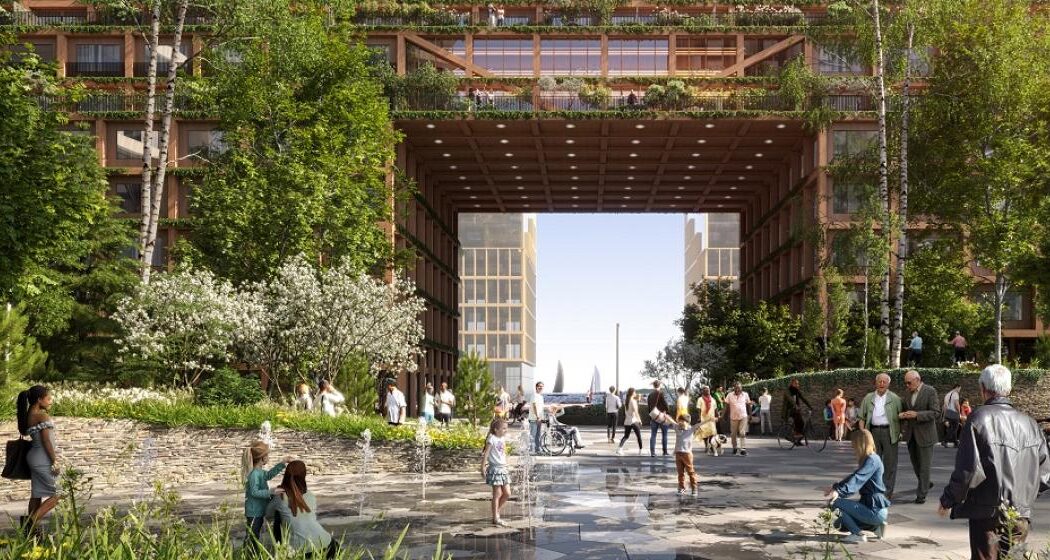On the waterfront of Toronto, Ontario, Canada, the property referred to as Quayside (pronounced kee-side) is an L-shaped area of land on the city’s eastern downtown waterfront, about the size of six soccer fields. But in this small (12.5 acres) space, something big and ambitious is happening. Again.
The “again” refers to the Sidewalk Toronto fiasco, wherein Alphabet/Google‘s now-defunct Sidewalk Labs division proposed to create a world-class “smart city”.
While that project’s failure can mostly be blamed on the leadership of both Sidewalk Labs and Waterfront Toronto (which now has a new leader), there were plenty of missteps by local, provincial and national governmental leaders, all the way up to Prime Minister Justin Trudeau. Just days ago (on February 10, 2023), Toronto Mayor John Tory resigned for reasons unrelated to Sidewalk, but that embarrassment on his record certainly didn’t help.
Eventually, COVID-19 was blamed for the Sidewalk Toronto failure, a scapegoat that helped everyone save face. For a thorough understanding of what went wrong, read the excellent new book, SIDEWAYS: The City Google Couldn’t Buy, by Josh O’Kane (Random House Canada, 2022).
While the mistakes were many and varied, my (Storm Cunningham) own take is that they can mostly be traced back to two fundamental flaws in the planning process. The first was a vision failure: Sidewalk’s vision involved hundreds of acres, whereas Waterfront Toronto’s vision involved only the 12.5 acres of Quayside.
The second was a strategic failure. As documented in my 2020 book, RECONOMICS: The Path To Resilient Prosperity, the primary purpose of a strategy is to overcome the major obstacles to achieving the vision.
The primary obstacle in this case (lack of trust) was never formally identified as a key challenge, so the strategy (if they even had one, which I doubt) ended up focusing mostly on design (which is a sure path to failure at such as early stage of the game), and on data ownership/privacy issues.
The Sidewalk debacle was far removed from what former Waterfront Toronto CEO John Campbell described to me as his vision of the future, as we chatted in his office some 15 years ago. (Campbell wisely resigned just as the Quayside initiative was getting underway.)
Now, the effort to revitalize Quayside is itself being revitalized. There’s no discernable Google involvement, with the possible exception of using one or two of the urban data apps that Sidewalk Labs developed during that period.
Here’s how Waterfront Toronto describes the relaunched initiative:
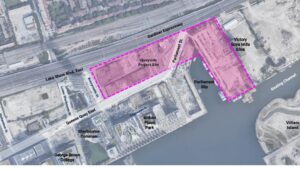 Quayside is a response to the challenge of how to build a dynamic, inclusive and resilient community for people of all ages, backgrounds, abilities and incomes. It will provide housing options for individuals and families and allow residents to age in place. It will be a complete community where residents will have easy access to their day-to-day needs – like food, shopping, recreation and green public spaces. Quayside’s aspiration to make the waterfront more inclusive means it must welcome more than just those who have been able to afford it. And, it must support vibrant activities and economic opportunities, especially for equity-deserving communities.
Quayside is a response to the challenge of how to build a dynamic, inclusive and resilient community for people of all ages, backgrounds, abilities and incomes. It will provide housing options for individuals and families and allow residents to age in place. It will be a complete community where residents will have easy access to their day-to-day needs – like food, shopping, recreation and green public spaces. Quayside’s aspiration to make the waterfront more inclusive means it must welcome more than just those who have been able to afford it. And, it must support vibrant activities and economic opportunities, especially for equity-deserving communities.
In a post-pandemic context, Quayside is also an opportunity to reimagine a community that addresses many of the vulnerabilities and inequities that the COVID-19 pandemic has exposed. In short, Quayside’s success is about people, and its outcomes will be improvements in the quality of life for residents, workers and visitors.
Quayside is being developed by experienced Toronto developers Dream and Great Gulf Group, together known as Quayside Impact Limited Partnership, or Quayside Impact for short. Collaborating with some of the world’s leading architects, designers and problem-solvers, Quayside Impact was selected through an international competition as Waterfront Toronto’s development partner for Quayside in February 2022, and a project agreement was completed in December 2022.
Creating A New Type Of Community
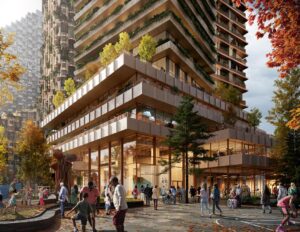 Waterfront Toronto’s objectives for Quayside are simply defined as creating and maintaining a dynamic, inclusive and resilient community. But what does such a community look like?
Waterfront Toronto’s objectives for Quayside are simply defined as creating and maintaining a dynamic, inclusive and resilient community. But what does such a community look like?
A dynamic community is one that enhances the lives of residents and visitors by being inviting, beautiful and lively during all four seasons. It provides public spaces, amenities and activities, is thoughtfully designed with places to shop, be active, and engage with arts and culture, and is connected to surrounding neighbourhoods and nature.
An inclusive community is a place for all, equally inviting to people along all dimensions of diversity, demography, identity and ability.
A resilient community is one that is equipped to thrive – environmentally, socially and economically. One built with sustainability as a first principle and demonstrating climate leadership by reducing greenhouse gas emissions and managing the effects of extreme weather events.
So how will Quayside Impact’s plan for Quayside achieve these goals? The development plan feature a number of highlights:
- A mix of market rate and affordable housing, including more than 800 affordable housing units – more than half of which will be two-bedroom and larger for families. Importantly, the affordable units will be spread across Quayside and a portion will be delivered in each phase of development. These units will ensure Quayside offers housing for all, regardless of income, as well as help address Toronto’s urgent need for more affordable housing.
- The residential space, along with commercial, institutional and retail space, will be located across five towers and Canada’s largest mass-timber residential building running along the north side of Queens Quay East.
- 3.5 acres of accessible public space across the site, including a 2-acre car-free urban forest, which will provide exposure to nature and promote physical and mental health.
- A 1-acre urban farm on the rooftop of the mass-timber building that will be accessible to residents and the public, creating an opportunity for community gardens.
- An all-electrically powered, zero-carbon community built with sustainability as a first principle. By using more sustainable materials and technologies, promoting biodiversity and creating comfortable and accessible green spaces for all seasons and types of weather, Quayside will reduce greenhouse gas emissions and manage the effects of extreme weather events.
- A Community Care Hub that will promote physical and mental well-being for residents through offering community resources, services and programming, such as daycare, seniors’ services, and medical services.
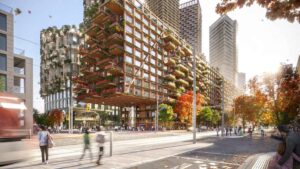 Quayside will be developed in phases, beginning with three iconic buildings designed by architects Adjaye Associates, Alison Brooks Architects and Henning Larsen, and landscape design created by SLA Architects. Each building will provide a unique sense of place through high-quality design, attractive natural areas and space for retail, cultural and community uses.
Quayside will be developed in phases, beginning with three iconic buildings designed by architects Adjaye Associates, Alison Brooks Architects and Henning Larsen, and landscape design created by SLA Architects. Each building will provide a unique sense of place through high-quality design, attractive natural areas and space for retail, cultural and community uses.
Quayside Impact introduced its master plan concept and early-stage designs to Waterfront Toronto’s Design Review Panel last week. The panel considered the project’s context, design strategy and how that design will meet the dynamic, inclusive, and resilient objectives.
While it is still early days, the panel expressed excitement about the many innovative concepts contained within the plans and is looking forward to Quayside Impact’s return for a more detailed review. You can view the presentation to the panel here. More details will be shared in the coming days, weeks, months and years.
What Principles Will Shape Quayside’s Evolving Design?
As more work is done to bring Quayside to life, and as its designs are refined, a fundamental set of design principles will guide this work:
- Indigenous design principles and teachings based on understanding, respecting, and living in harmony with the land, water, and all its beings;
- Integrate the natural world and sustainability into every experience;
- Quayside will be both a community for residents and a waterfront destination with multiple activities, experiences and uses;
- Connect the city to the waterfront and the waterfront to Lake Ontario; Quayside will also be the hinge that connects the downtown waterfront to Keating Channel and the future Villiers Island;
- Universally accessible public spaces designed to accommodate a wide range of activities; and
- Create a rich and varied experience through design and world-class architecture that reflects diverse perspectives and experiences.
What Happens Now?
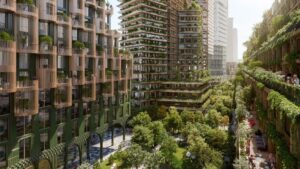 Like other waterfront communities, Quayside has been the focus of significant public engagement and consultation. With the selection of Quayside Impact as the development partner and the next phase of work now underway, public engagement will continue to play an important role in how designs are refined and brought to life and how this place will meet the objectives of being a dynamic, inclusive and resilient community.
Like other waterfront communities, Quayside has been the focus of significant public engagement and consultation. With the selection of Quayside Impact as the development partner and the next phase of work now underway, public engagement will continue to play an important role in how designs are refined and brought to life and how this place will meet the objectives of being a dynamic, inclusive and resilient community.
Engagement will also be important in how Quayside integrates into the surrounding area, which will be undergoing a significant transformation in the coming years. The transformation being led by Waterfront Toronto includes improvements to the public realm along Queens Quay East, the realignment of the foot of Parliament Street, a re-imagined Parliament Slip, an extended Water’s Edge Promenade and future new park – Silo Park.
Quayside Impact will undertake the public consultation required as a part of the City of Toronto’s development and planning approval processes. And, in keeping with Waterfront Toronto’s long-standing practice, Quayside Impact will engage more broadly with the community and the many groups and interests that have a stake in Quayside achieving its objectives – not just as neighbours, but as potential residents, workers, visitors, students, farmers, programmers, educators, care workers, business owners and more.
Waterfront Toronto and Quayside Impact are working together to design this engagement plan, and more information will be made available on a website that Quayside Impact is launching very shortly.
Renderings courtesy of Waterfront Toronto.

